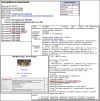Type material in the NCBI Taxonomy Database
- PMID: 25398905
- PMCID: PMC4383940
- DOI: 10.1093/nar/gku1127
Type material in the NCBI Taxonomy Database
Abstract
Type material is the taxonomic device that ties formal names to the physical specimens that serve as exemplars for the species. For the prokaryotes these are strains submitted to the culture collections; for the eukaryotes they are specimens submitted to museums or herbaria. The NCBI Taxonomy Database (http://www.ncbi.nlm.nih.gov/taxonomy) now includes annotation of type material that we use to flag sequences from type in GenBank and in Genomes. This has important implications for many NCBI resources, some of which are outlined below.
Published by Oxford University Press on behalf of Nucleic Acids Research 2014. This work is written by (a) US Government employee(s) and is in the public domain in the US.
Figures




References
-
- Linnaeus C. Species Plantarum. 1st edn. Stockholm: 1753. Two volumes. Laurentius Salvius.
-
- Linnaeus C. Systema Naturae. 10th edn. Stockholm: 1758. Two volumes. Holmiae Salvius.
-
- International Commission on Zoological Nomenclature. International Code of Zoological Nomenclature, Fourth Edition. International Trust for Zoological Nomenclature. London: The Natural History Museum; 1999.
-
- McNeill J, Barrie FR, Buck WR, Demoulin V, Greunter W, Hawksworth DL, Herendeen PS, Knapp S, Marhold K, Prado J, et al., editors. International Code of Nomenclature for Algae, Fungi, and Plants (Melbourne Code), Adopted by the Eighteenth International Botanical Congress Melbourne, Australia, July 2011. Bratislava: International Association for Plant Taxonomy; 2012.
Publication types
MeSH terms
Grants and funding
LinkOut - more resources
Full Text Sources
Other Literature Sources
Molecular Biology Databases

